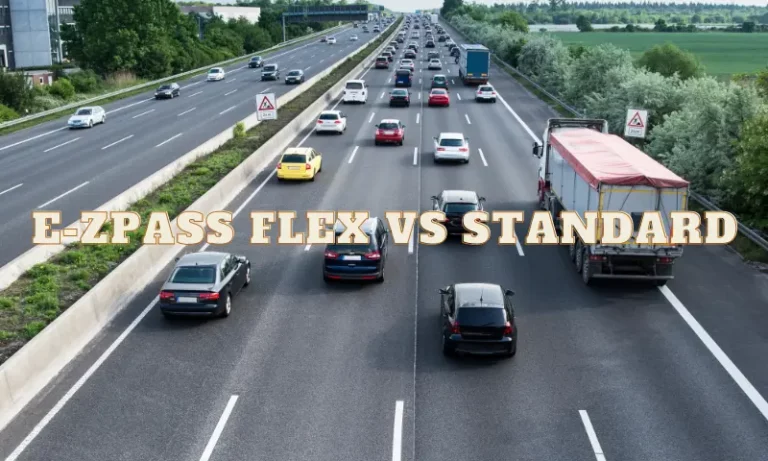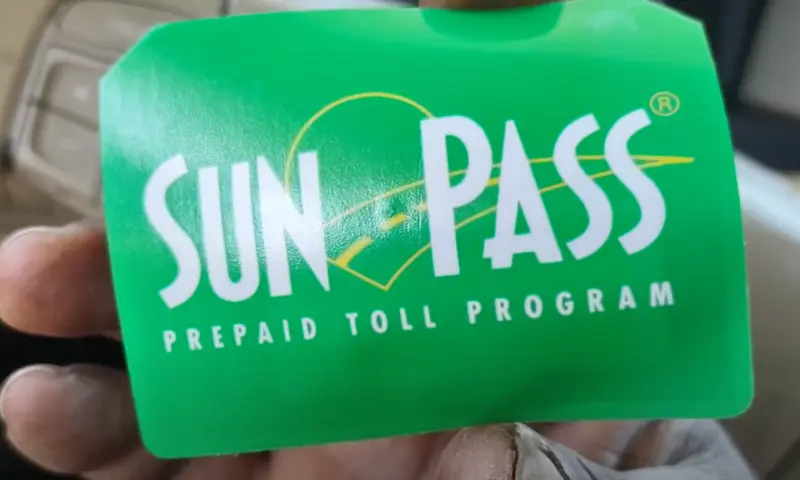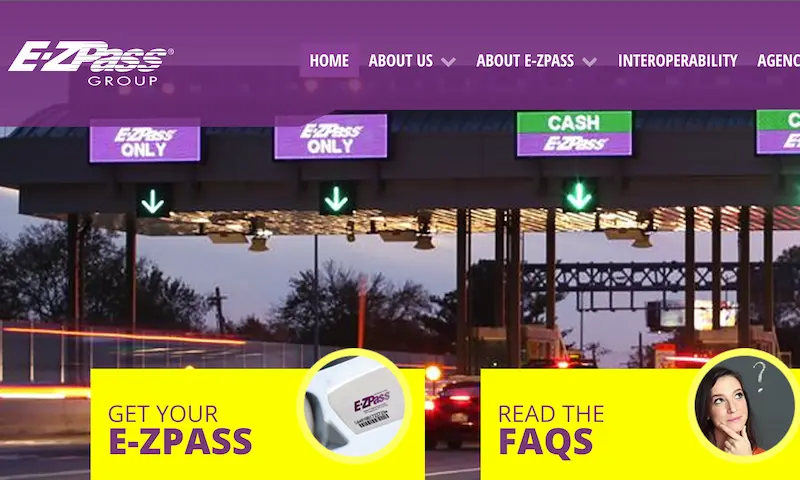Tired of waiting in long toll lines or wondering if you’re getting the best deal on your commute? If you regularly travel on toll roads in the Eastern or Midwestern United States, choosing the right E-ZPass transponder can save you significant time and money. While both E-ZPass Flex and Standard serve the same basic purpose, one key difference might make one option substantially better for your specific driving habits.
What Is E-ZPass and How Does It Work?
E-ZPass is an electronic toll collection system that’s been operating since 1987 across 17 states. The technology uses RFID (Radio Frequency Identification) to automatically deduct toll charges from your prepaid account as you drive through toll plazas.
Here’s the simple breakdown of how it works:
- A small transponder attaches to your windshield
- As you pass through toll areas, the transponder communicates with overhead equipment
- Tolls are automatically deducted from your account
- You drive through without stopping
Both E-ZPass Standard and Flex use identical RFID technology for this basic function, allowing you to zip through dedicated E-ZPass lanes much faster than cash lanes. Many states even offer discounts up to 50% for E-ZPass users compared to cash payments.
E-ZPass Flex vs Standard: The Key Differences
While both transponder types work identically on regular toll roads throughout the E-ZPass network, there’s one critical distinction that sets them apart.
The HOV Switch: Flex’s Game-Changing Feature
E-ZPass Flex includes a physical switch that allows vehicles with the required number of passengers to travel toll-free on designated Express Lanes. This is the primary difference between the two transponders.
The Flex transponder features a sliding switch that you set before entering Express Lanes:
- Switch right (showing “HOV ON”): Signals you have enough passengers to qualify for HOV status
- Switch left (hiding “HOV ON”): Sets to standard toll-paying mode
This seemingly small feature can translate to massive savings for carpoolers who regularly use Express Lanes, as the HOV setting allows you to bypass tolls entirely when carrying the required number of passengers.
Standard E-ZPass users, by contrast, pay the full toll regardless of how many people are in their vehicle.
Physical Appearance and Design
The Standard E-ZPass is a simple, rectangular white device without any movable parts. The Flex version looks nearly identical except for the sliding switch mechanism on one side that reveals or hides the “HOV ON” indicator.
Both types mount to your windshield in the same way, typically behind the rearview mirror, using adhesive strips.
Express Lanes and HOV Requirements: Understanding the Rules
Express Lanes are specialized toll facilities designed to manage traffic congestion by providing reliable travel time options. These lanes use dynamic pricing, where toll rates fluctuate based on real-time traffic conditions.
HOV Occupancy Standards Vary by Location
For E-ZPass Flex users, understanding local HOV requirements is crucial:
| State | Common HOV Requirement | Major Express Lane Locations |
|---|---|---|
| Virginia | HOV-3 (3+ people) | I-66, I-95, I-395, I-495, I-64 |
| Maryland | HOV-3 (3+ people) | I-495, I-270 (planned) |
| North Carolina | HOV-3 (3+ people) | I-77 (Charlotte area) |
| California | Varies (HOV-2 or HOV-3) | Various locations with 50% discounts for HOV-2 |
| Minnesota | HOV-2 (2+ people) | MnPASS system |
Enforcement of these requirements happens 24/7 through overhead cameras and law enforcement patrols. Attempting to use HOV mode without enough passengers can result in hefty fines of $250 or more – quickly erasing any savings you might have gained.
Where E-ZPass Flex Benefits Are Available
E-ZPass Flex HOV benefits currently operate in five states:
- Virginia (most extensive network)
- Maryland
- North Carolina
- Massachusetts
- Minnesota
If you don’t travel in these states or don’t use their Express Lanes, the Flex transponder offers no additional benefits over the Standard version.
Cost Comparison Between E-ZPass Types
Understanding the cost implications helps you make an informed choice between Standard and Flex options.
Initial Costs and Deposits
Costs vary significantly by state:
| State | Initial Deposit | Standard Replacement Fee | Flex Replacement Fee |
|---|---|---|---|
| Virginia | $35 (prepaid toll balance) | $10 | $20 |
| Massachusetts | $20 | Varies | Varies |
| Delaware | $40 | Varies | N/A |
| New York | $25 | Varies | N/A |
| Maryland | $25 | Varies | Varies |
In Virginia, where Flex is most widely used, both transponder types are provided free of charge, but you must make a $35 initial deposit that serves as your prepaid toll balance. The difference comes in replacement costs: $10 for Standard versus $20 for Flex if lost or damaged.
Monthly Fees and Usage Requirements
Most states have eliminated monthly maintenance fees, though some exceptions exist:
- New Jersey: $1 monthly service fee
- Ohio: $0.75 monthly fee (waived with 30+ monthly uses)
E-ZPass Flex users in Virginia face a unique requirement: you must use HOV mode at least once every 6-12 months to avoid a $10 non-use fee. This requirement exists because Flex transponders cost more to manufacture, and the fee encourages active usage by people who actually need the HOV functionality.
Who Should Choose E-ZPass Flex?
E-ZPass Flex makes the most sense for these driver profiles:
Regular Carpoolers on Express Lanes
If you frequently travel with enough passengers to meet HOV requirements on Express Lanes, Flex is the clear winner. With Express Lane tolls often ranging from $5-20 per trip depending on traffic conditions, the savings add up quickly for regular carpoolers.
For example, a daily commuter on Virginia’s I-66 Express Lanes who carpools with two colleagues could save over $2,000 annually by using E-ZPass Flex in HOV mode versus paying tolls with a Standard transponder.
Families Who Often Travel Together
Parents who regularly transport multiple children on routes with Express Lanes will benefit significantly from the Flex option. Since children count toward HOV requirements (regardless of age in most jurisdictions), family vehicles often naturally meet the passenger threshold.
Commuters with Variable Occupancy
If you sometimes travel alone and sometimes with passengers on Express Lanes, the Flex transponder gives you flexibility. You can pay tolls when driving solo and switch to HOV mode when carpooling.
Who Should Stick with E-ZPass Standard?
The Standard E-ZPass is likely better for these situations:
Solo Drivers
If you primarily drive alone, the Standard transponder provides all the benefits of electronic toll collection without the added complexity of the HOV switch that you’d rarely, if ever, use.
Drivers Outside Express Lane Areas
If you don’t regularly travel on Express Lanes in states that offer HOV discounts, there’s no advantage to having the Flex version. The Standard transponder works on all regular toll roads, bridges, and tunnels throughout the E-ZPass network.
Occasional Toll Road Users
For those who only occasionally use toll facilities, the simpler Standard transponder avoids the usage requirements and higher replacement costs associated with Flex.
How to Use E-ZPass Flex Correctly
If you opt for the Flex transponder, proper usage is crucial to avoid both toll charges and potential violations.
Setting the Switch Properly
Always set the switch before starting your trip while your vehicle is parked. Never attempt to change the switch position while driving, as this is both dangerous and may result in incorrect toll charges.
When traveling with enough passengers to meet HOV requirements:
- Slide the switch right to reveal “HOV ON”
- Confirm the setting before entering Express Lanes
- Leave it in this position throughout your journey on Express Lanes
When traveling alone or with fewer than required passengers:
- Slide the switch left to hide “HOV ON”
- Pay the toll like any other E-ZPass user
Avoiding Enforcement Issues
Express Lanes use sophisticated enforcement technology:
- Overhead cameras capture vehicle occupancy
- When your Flex transponder is in HOV mode, lights flash as you pass under toll gantries
- Law enforcement officers verify occupancy compliance
- License plate cameras identify vehicles and cross-reference with transponder settings
To avoid problems:
- Be honest about your passenger count
- Understand specific HOV requirements for each facility you use
- Keep your license plate information current in your E-ZPass account
- Never attempt to manipulate the system, as fines far exceed toll savings
Comparing Performance and Reliability
Both transponder types demonstrate excellent reliability for their basic toll collection function. The E-ZPass system has decades of operational history and works consistently across the network.
The Flex transponder introduces only one additional point of potential failure: the mechanical switch. While generally reliable, the moving parts could potentially malfunction over time. However, most users report years of trouble-free operation.
If your transponder ever fails to register properly, most toll facilities have camera systems that capture your license plate as backup. As long as your plate is registered to your E-ZPass account, the system typically processes the toll correctly even without a transponder reading.
How to Get the Right E-ZPass for Your Needs
Obtaining either E-ZPass type is straightforward:
Application Process
You can apply for an E-ZPass through your state’s toll authority website, at customer service centers, or sometimes at retail locations like grocery stores or DMVs. The E-ZPass Virginia website offers online applications for both Standard and Flex transponders.
When applying, you’ll need:
- Vehicle information (make, model, year, license plate)
- Credit card or banking information for account funding
- Personal contact information
Switching Between Transponder Types
If your commuting patterns change, you can usually exchange your transponder type:
- Standard to Flex: Visit a customer service center to upgrade
- Flex to Standard: Exchange if you no longer need HOV functionality to avoid usage requirements
Future Considerations for E-ZPass Users
The E-ZPass system continues to evolve, with several trends worth noting:
Expanding Express Lanes Networks
More states are developing Express Lanes projects, with Maryland planning major expansions on I-270 and I-495. This growing network makes Flex transponders increasingly valuable for regular commuters in these corridors.
Technological Improvements
While the basic RFID technology remains unchanged, account management capabilities continue to improve. Mobile apps now allow users to monitor their accounts, add funds, and track travel history more easily than before.
Policy Changes
HOV requirements occasionally change based on traffic patterns and policy goals. For example, some facilities have shifted from HOV-2 to HOV-3 requirements in recent years. Staying informed about these changes helps maximize your savings.
Making Your Decision: Flex or Standard?
When choosing between E-ZPass Flex and Standard, consider these final points:
- Honestly evaluate your current carpooling patterns rather than hypothetical future scenarios
- Calculate potential savings based on your typical Express Lanes usage
- Consider the higher replacement cost and usage requirements for Flex
- Remember you can exchange transponder types later if your needs change
For most drivers who even occasionally carpool on Express Lanes, the Flex transponder offers significant potential savings that easily outweigh the minor additional complexities. However, if you rarely or never travel with enough passengers to meet HOV requirements, the Standard transponder provides all the basic E-ZPass benefits without unnecessary features.
The right choice ultimately depends on your specific driving patterns, routes, and passenger counts. Either way, both options offer substantial improvements over cash toll payments, with faster travel times and typically lower toll rates across the E-ZPass network.
















